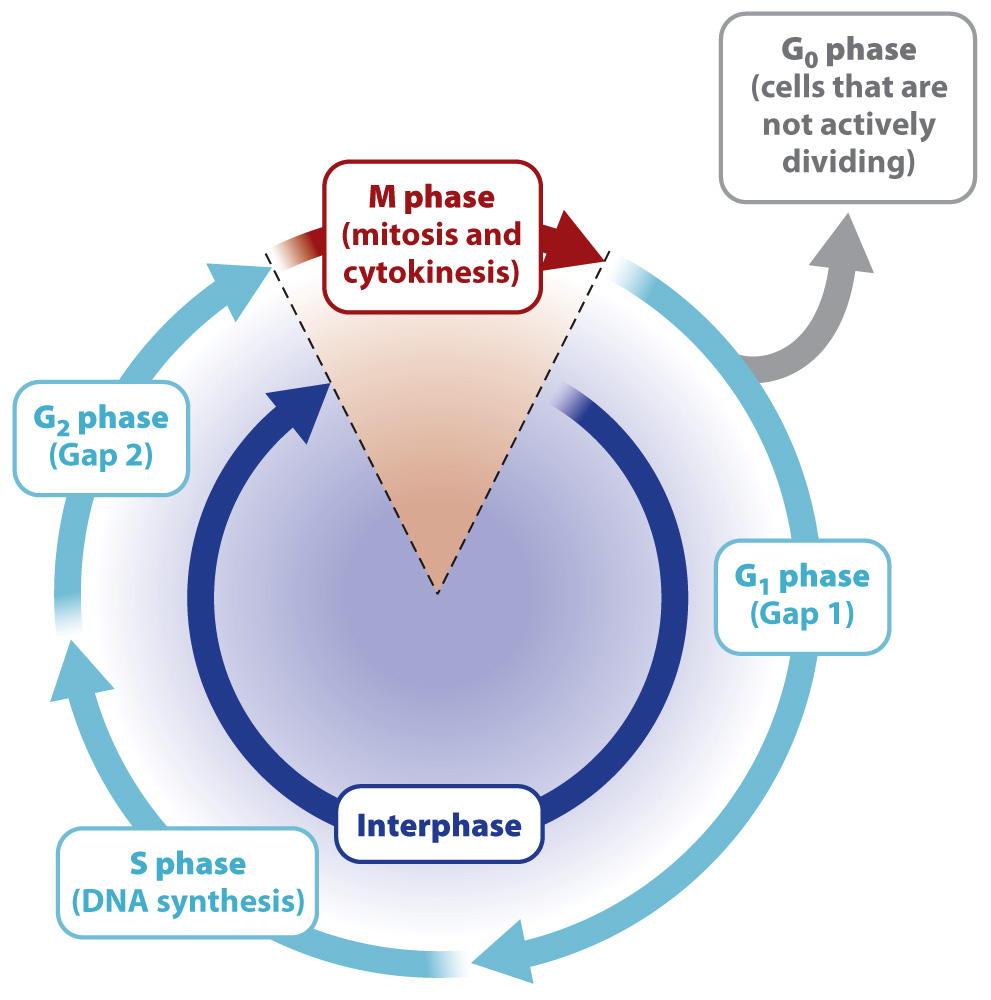The cell cycle describes the life cycle of a eukaryotic cell.
Cell division in eukaryotic cells proceeds through a number of steps that make up the cell cycle (Fig. 11.2). The cell cycle consists of two distinct stages: M phase and interphase. During M phase, the parent cell divides into two daughter cells. M phase consists of two different events: (1) mitosis, the separation of the chromosomes into two nuclei, and (2) cytokinesis, the division of the cell itself into two separate cells. Usually, these two processes go hand in hand, with cytokinesis typically beginning even before mitosis is complete. In most mammalian cells, M phase lasts about an hour.

The second stage of the cell cycle, called interphase, is the time between two successive M phases (Fig. 11.2). For many years, it was thought that the relatively long period of interphase is uneventful. Today, we know that during this stage the cell makes many preparations for division. These preparations include replication of the DNA in the nucleus so that each daughter cell receives a copy of the genome, and an increase in cell size so that each daughter cell receives sufficient amounts of cytoplasmic and membrane components to allow it to survive on its own.
Interphase can be divided into three phases, as shown in Fig. 11.2. Among the many preparations that the cell must make during interphase, one particularly important task is the replication of the entire DNA content of the nucleus. Since replication involves the synthesis of DNA, this stage is called S phase (“S” for “synthesis”).
In most cells, S phase does not immediately precede or follow mitosis but is separated from it by two gap phases: G1 phase between the end of M phase and the start of S phase, and G2 phase between the end of S phase and the start of M phase. Many essential processes occur during both “gap” phases, despite the name. For example, during the G1 phase, specific regulatory proteins are made and activated. Once active, the regulatory proteins, many of which are kinases, then promote the activity of enzymes that synthesize DNA. In the G2 phase, both the size and protein content of the cell increase in preparation for division. Thus, G1 is a time of preparation for S-
How long does a cell take to pass through the cell cycle? That depends on the type of cell and the organism’s stage of development. Actively dividing cells in some human tissues such as the intestine and skin require frequent replenishing. It usually takes cells in these tissues about 12 hours to complete the cell cycle. Most other actively dividing cells in your body take about 24 hours to complete the cycle. A unicellular eukaryote like yeast can complete an entire cell cycle in just 90 minutes. Champions in the race through the cell cycle are the embryonic cells of some frog species. Early cell divisions divide the cytoplasm of the large frog egg cell into many smaller cells and so no growth period is needed between cell divisions. Consequently, there are virtually no G1 and G2 phases, and as little as 30 minutes pass between cell divisions.
Not all the cells in your body are actively dividing since not all tissues require the rapid replenishing of cells. Instead, many cells pause in the cell cycle somewhere between M phase and S phase for periods ranging from days to more than a year. This period is called the G0 phase and is distinguished from G1 by the absence of preparations for DNA synthesis (Fig. 11.2). Liver cells remain in G0 for as much as a year. Other cells such as nerve cells and those that form the lens of the eye enter G0 permanently; these cells are nondividing. Thus, many brain cells lost to disease or damage cannot be replaced. Although cells in G0 have exited the cell cycle, they are active in other ways—